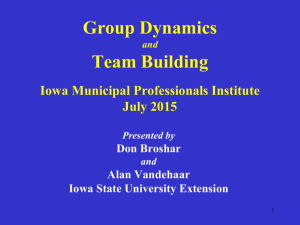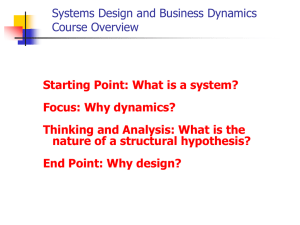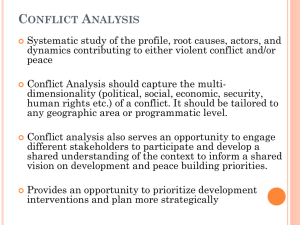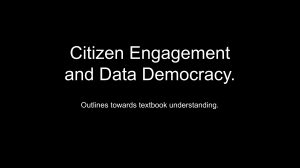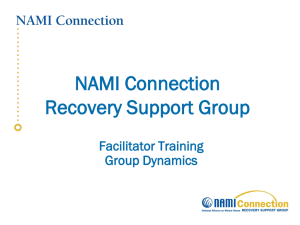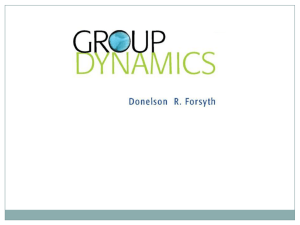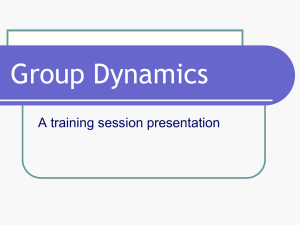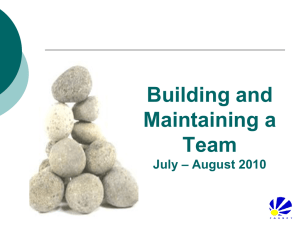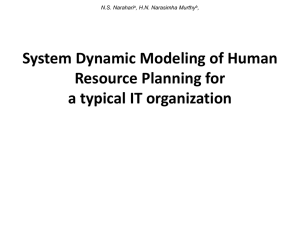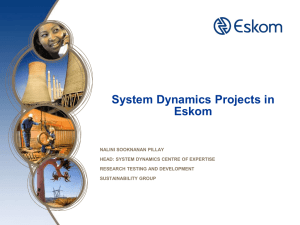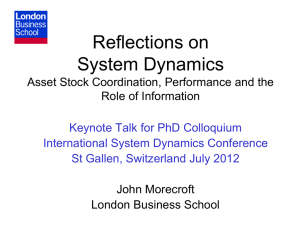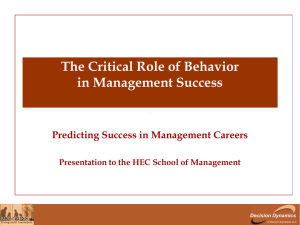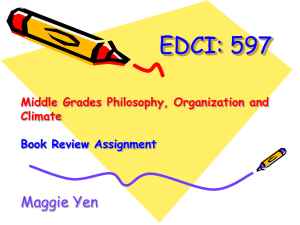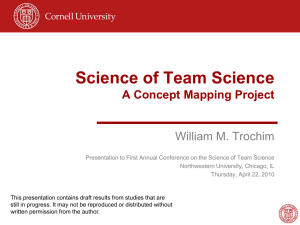Master Presentation - Iowa State University Extension and Outreach
advertisement
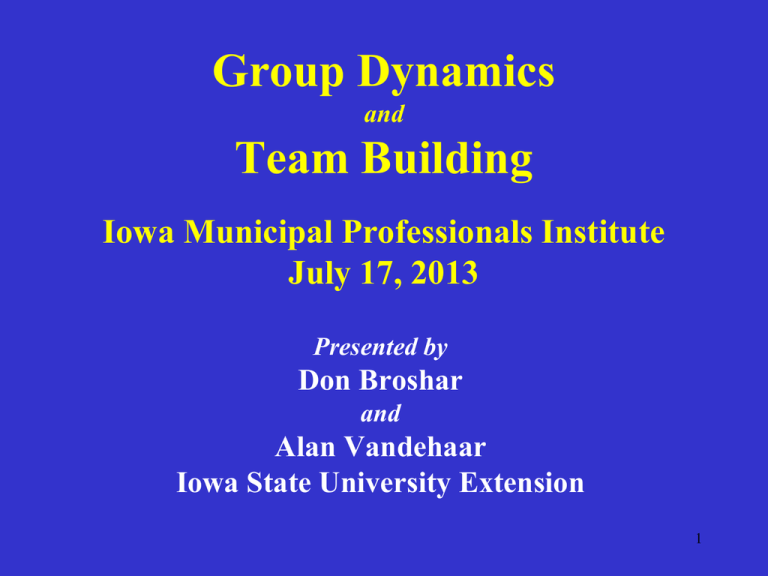
Group Dynamics and Team Building Iowa Municipal Professionals Institute July 17, 2013 Presented by Don Broshar and Alan Vandehaar Iowa State University Extension 1 Group Dynamics & Team Building PURPOSE OF PROGRAM • To give you a greater understanding of group dynamics and team work • To give you tools and strategies so you can positively influence group dynamics and create more effective teams - for a better work environment at city hall 2 Group Dynamics & Team Building Agenda • • • • • • • • Effective Communication Effective Meetings Group Phases and Member Roles Group Dynamics in Action Dealing with Difficult People Building Teams in Local Government Understanding Yourself and Others Teamwork in Difficult Situations 3 Definitions • Group Dynamics • A group of two or more people interacting with each other in a manner that each person influences and is influenced by each other person 4 Definitions (more) • Team • Two or more people working together to achieve a shared goal • Team Building / Team Work • The process of getting people to work together effectively to achieve a shared goal 5 The Biggest Challenge? • Getting People To W____ T________! 6 Communication Exercise An exercise to demonstrate effective communication 7 Communication Exercise – What Did We Learn? • One-way communication is ineffective when two-way communication is needed. • Listening is just as effective as talking • What we say is often not what people hear • It is difficult to describe visual pictures or objects 8 Planning and Managing Effective Meetings Presented at the Iowa Municipal Clerk’s Institute Prepared By Alan Vandehaar Iowa State University Extension 9 Why be concerned with more effective meetings? • Meetings are a key aspect of the group decision-making process • Meetings fundamental for democratic institutions in the public sector 11 Why Do People Meet? • List some reasons: • • • • • • • • • Share and/or gather information Learn about or better understand an idea Build group support for a goal Express unity of purpose Make decisions Accomplish a goal Have some fun - social aspects People meet for many reasons Recognize people want something from meeting12 Planning and Managing Effective Meetings • To Manage (defined): -To direct, to arrange -To succeed in accomplishing or achieving 13 Criteria For Failed Meetings Two major roadblocks to effective meetings 1. Between participants, different personal, cultural experiences, various desired meeting outcomes, personal agendas 2. Lack of action from a meeting; groups can’t or won’t make a decision; conflict between talkers and doers 14 Group Phases • In planning and conducting effective meetings it can help if you have some understanding of group dynamics. • It is normal for groups, especially new groups, to go through stages (phases) 15 Stage 1: Forming • Group is a bunch of individuals • Mood is upbeat, uptight, as meeting new people can be exciting & nerve-wracking • May be anxiety and confusion • Members must get acquainted and decide to cooperate • Members define their roles, how to make decisions, set goals 16 Stage 2: Storming • Anxiety increases, group morale can sink. There may be conflict • Anxiety is normal; essential tension, energy • OK for group to disagree • Manage this stage by generating ideas to solve problems; Ideas are key to group creativity 17 Stage 3: Norming • You begin to act as a group • Group begins to have identity, clearer expectations and norms(informal rules) about group behavior become apparent • Group has cohesion; members like each other and want to work; group has value • OK to share doubts, explore alternative ideas on ways to set and reach goals 18 Stage 4: Performing • Group “gets down to business” • Leaders delegate responsibilities and group members go to work • Group’s resources are fully mobilized to reach your goal 19 Stage 5: Transforming • Groups may go back to earlier phases; may regroup to tackle a new task • Group may disband after accomplishing it’s goals • Some members may leave group, others may join • May be time of joy, sadness, satisfaction 20 Stages of Group Development Group Phases Forming – Storming – Norming – Performing High Morale Low Amount Of Work Begin >>>>>>>>>>>>> Time >>>>>>>>>>>>>>>> End 21 Group Member Roles: Recognizing The Roles • People play positive and negative roles in groups and meeting • The following exercise is designed to help us better understand the negative roles people play, and then develop strategies to overcome these negative roles 22 Group Member Roles • Three Major Roles: • Task Roles • Maintenance Roles • Individual Roles 23 Task Roles • A Positive Role • To solve a problem or accomplish a task (For example: Take meeting minutes & send out; set up room for meeting; election of officers) 24 Maintenance Roles • A Positive Role • To help members of the group interact more effectively = team building (For example: encourage all to participate; promote compromise; strive for group consensus) 25 Individual Roles • Negative Role • Promote personal needs and selfinterest above the overall interest of the group 26 Two Group Skits = Individual Roles Exercise • Hands-on activity to illustrate the individual or negative roles that people can play in groups/meetings • Worksheet to identify roles played in skit 27 Dealing With Difficult People • See Handout: Strategies For Dealing With Difficult People 28 Key Elements of Effective Meetings: Before the Meeting? • What should be done before the meeting? • Make sure there is a reason to meet • Prepare a written agenda, with others’ input • Send out agenda ahead of meeting; may use email, or postal mail • Arrange a pleasant physical setting 29 During the Meeting • What should be done during the meeting? • Begin on time • Consider ice-breakers, team building, use name tents to welcome new members • Establish ground rules for all to follow; as a handout or post a flip chart of these on wall • Decide how decisions are to be made (consensus, majority vote, or chairperson) 30 Meetings Guidelines: (A.K.A. Ground Rules) • • • • • • • • Everyone participates No one dominates Listen carefully Be constructive Share new ideas Respect other opinions One conversation at a time (Have some fun*) *with limits, as appropriate 31 During the Meeting • Follow the agenda Mail/send before the meeting Review and approve at start of meeting State purpose of meeting Place most important items first Assign time frame for each item, allocating time based on importance 32 During the Meeting • Assign jobs of recorder, time watcher, other key roles (“engager”); everyone should have a role in each meeting; may rotate roles at next meeting • Record ideas/decisions on flip chart to see, using bold marker, large print for all to see • Near end of meeting, verify date, time, place of next meeting • In closing, verify assigned responsibilities of members • End on time! 33 The Agenda • Agenda is the written order of business; without an agenda, chaos! • Agenda can help your group: - Brainstorm, Get Feedback, Report, Make Decisions, Plan, Solve Problems - Essential to start on time, stay focused on key issues, and end on time 34 Agendas • Includes… • Date, time, location of meeting; include name of contact person • Who writes the agenda? Chairperson or leader Ask some other members for input Let members know ahead of meeting if they are to report 35 After the Meeting • Review the meeting – problems and success • Remind all participants of assignments and plans for the next meeting • Send all participants copy of minutes (mail or email) 36 The Meeting Environment – Important Points! • What are attributes of a good meeting setting? • Moveable tables and comfortable chairs • Quiet, well-lighted, well-ventilated • Comfortable temperature • Restrooms nearby • Equipment on hand: flip chart, easel, etc • Wall space to post flip charts • Refreshments can build group cohesiveness • Set up room for all to see and hear others 37 Setting Up The Meeting Environment Table Arrangement and Seating Suggestions: “A” or “B” ? Why? A B 38 Components of Effective Meetings • • • • • • Skilled leader- knows the “art” of leading meetings Committed, involved members Meaningful purpose of group & meeting Meeting pre-planning Conducive physical setting, arrangement Use effective procedure to help group reach it’s goals in a timely manner • Consider meeting guidelines • Use a written agenda • Deal with difficult people 39 Strategies to Enhance Teamwork 1. Clear roles and shared expectations 2. Council orientation & ongoing learning 3. Planning for future – set L. R. goals 4. Good reporting systems- communications 5. Effective meeting management 6. Informal workshops /council work sessions 7. Reduce surprises for council and staff 8. Knowledge of law, policies and procedures For above, assess areas of needs, work on these 40 Group Dynamics and Team Building Summary Review What have we learned today? 41 Group Dynamics and Team Building • Group dynamics – interaction • Understanding yourself and others to build more effective ‘work teams’ • Biggest Challenge? • Getting People to Work Together 42 Group Dynamics and Team Building • Group Phases • Recognize that groups go through phases and effectiveness can change in each phase • Group Member Roles • All members of a group need to play a (positive) role, contributing to group goals 43 Group Dynamics and Team Building • Dealing with Difficult People • Some people play negative roles • Use the “Strategies” handout for tools to deal with those playing negative roles 44 Group Dynamics and Team Building • • • • • Effective Meetings Plan ahead Help people prepare ahead for meeting Start, end on time Use agenda with times, and ground rules 45 Group Dynamics and Team Building • Meetings – continued • Put most important items early on agenda • At end, verify assignments, the work to do before next meeting • Meeting environment – important for more effective meetings 46 Group Dynamics and Team Building • COLORS • • • • Understanding yourself and others All colors bring strengths to a team Blue, Green, Gold, Orange Utilize colors to get people to work together 47 Importance of Team Work in Municipal Governance Team Work is important in city government: 1. Inherent interdependence; all in it together 2. Image - public perception, democracy works 3. Effectiveness and efficiency = better service 4. High quality workplace = more job satisfaction and less stress 48 Key Word Review - 1 • Anecdoter – throws discussion off track • Communication – process of sending a message to another person and receiving feedback from that person • Dominator – monopolizes discussion • Group Dynamics- energy produced from interaction of people together 49 Key Word Review - 2 • Group Member Roles – individuals play positive and negative roles in groups, determined by individual behavior in the group • Groups – individuals associated for some purpose or goal • Individual Roles – negative roles promoting personal, self-interest 50 Key Word Review - 3 • Judgment – way of coming to conclusions about what you perceive (take in info) • Maintenance Roles – help members of group work together to reach goals • Perception – ways we become aware of people, things, and ideas • Personality Temperament – manner of thinking, behaving, reacting to a person 51 Key Word Review - 4 • Task Roles – roles related to working on a task in a group • Temperament – manner of thinking, behaving, reacting to another person 52 Group Dynamics and Team Building Thank you for your attention today 53
